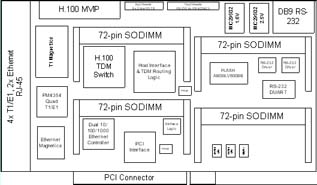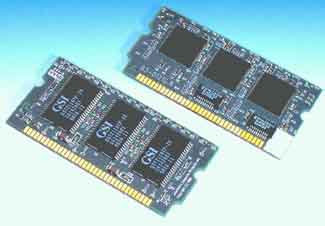SigC54/55xx-PCI Multiple DSP and Telephony/Analog I/O BoardBoard no longer recommended for new designs; please see the following alternatives instead SigC54/55xx-PCI Multiple DSP and Telephony/Analog I/O Board
OverviewThe SigC54/55xx-PCI board uses a modular approach to provide up to 7.2 GIPS in a single PCI card slot. The board accepts modules with Texas Instruments C54xx and C55xx DSP processor and modules with 16-bit audio and speech analog I/O. It is suitable for embedded telecom and Internet infrastructure applications where space is at a premium. Applications for the SigC54/55xx-PCI board include base-station processing, VoIP (voice-over Internet protocol) networking functions, VoDSL (voice-over DSL), Internet routing, multiple-channel speech or audio code / decode (e.g. G.729A or MELP speech compresion and MP3 audio compression), modem banks, echo cancellation, and speech recognition. The modular approach used by the SigC54/55xx-PCI board is particularly well suited to providing a scalable solution for telecom and Internet equipment applications that require multiple DSP devices. For example, channel capacity is highly configurable and upgradeable. The SigC54/55xx-PCI board is a "short form" PCI format board, fully compliant with PCI specification v2.2 (PCISIG, "Conventional PCI") both electrically and mechanically. The dimensions of the board are 170 mm (length) x 97 mm (height, not including PCI edge connector). In addition to RJ-45 connectors, the SigC54/55xx-PCI backplate has a bank of eight (8) tri-color LEDs that provide board and DSP status. SigC54/55xx-PCI Feature Summary
Specifications and Data SheetsT1/E1 Quad Telephony InterfaceThe SigC54/55xx-PCI board contains a PMC Sierra PM4354 quad T1/E1 device with integrated framers and transceivers that provides a telephony interface available on both a standard MVIP H.100 connector and four (4) RJ-45 connectors (located at the board backplate, using RJ-48C electrical wiring specification). In addition to the RJ-45 connectors, the telephony interface includes onboard magnetics and activity/status indicators (LEDs). Command, control, and status information is available to the host interface, and all TDM data is routed to the DSP module sites, via the programmable PLD switch matrix. Dual 10/100/1000 Ethernet InterfaceThe SigC54/55xx-PCI board contains a PMC Sierra PM3386 dual 10/100/1000 Mbps Ethernet device, and provides external interface on two (2) RJ-45 headers at the board backplate. In addition to the RJ-45 connectors, the Ethernet Interface includes onboard transceivers, magnetics and activity/status indicators (LEDs built into the RJ-45 connectors at the board backplate). POTS Telephony InterfaceThe SigC54/55xx-PCI contains 2x quad-SLAC devices (2x "QSLAC" devices) and 8x SLIC devices and associated circuitry, to allow connection to four (4) sets of 2-line POTS connections (8 POTS lines total). Magnetics and RJ-11 connectors are not located on the board; instead, 8x2 dual inline headers are provided at the top of the board for ribbon cable connection to four (4) external RJ-11 connectors. Command, control, and status and all TDM data are routed to the DSP module sites, via the programmable PLD switch matrix. TDM Routing PLDThe SigC54/55xx-PCI board contains an onboard PLD logic device that allows flexible serial port/TDM routing capabilities. For example, PLD logic is used to multiplex both quad SLAC devices into one (1) TDM stream to match the natural architecture of the C54xx/C55xx DSP family and facilitate DSP software development. As another example, the PLD logic allows quad T1/E1 data to be routed to any combination of DSP module sites. Analog I/OCombined with SigC54xx/C55xx processor modules, the SigSD4-SODIMM Audio Module offers multichannel 16-bit sigma-delta analog I/O as an integrated component in the modular solution. Audio Module features include:
Serial I/O InterfaceThe SigC54/55xx-PCI card provides four (4) synchronous serial channels and two (2) RS-232 asynchronous serial channels. All serial I/O signals are available at board edge; routing is software-programmable and levels are software-programmable for either RS-422 or RS-423 (balanced or unbalanced). SigC54/55xx-PCI Software Support The SigC54/55xx-PCI card, as well as other C54xx/C55xx platforms such as the Texas Instruments DSK C5402 board, are supported by Signalogic off-the-shelf DSP software products designed for DSP-based real-time processing and C54xx/C55xx DSP code development, including:
|





